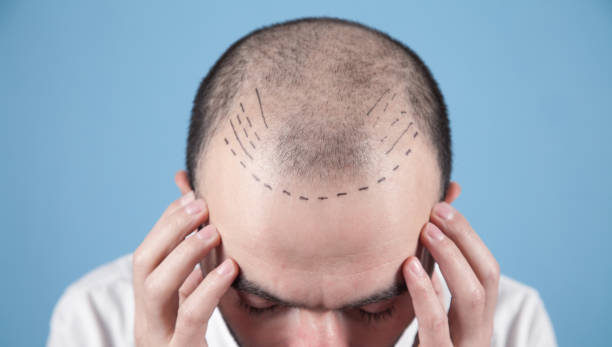If you are experiencing hair loss and are in Kathmandu, you may be wondering where to turn for the best hair transplant solution.
Hair loss can be a difficult and emotional experience for many people. It can affect one’s self-esteem and confidence.
Hair transplant surgery has come a long way in recent years, and it can be difficult to know which method is best for you.
Feeling self-conscious about hair loss? Take the first step towards a fuller head of hair. Learn more about hair transplant options in Kathmandu.
Click here to visit the main service page.
Hair fall/ Baldness
Hair, like good health and youth, is an essential element of one’s life. Your hairstyle and its length are distinguishing characteristics of a person’s personality.
Hair can make a person appear more appealing, but losing hair can also reduce a person’s self-confidence and openness in public.
No one wants to lose their hair if they had the option, but we all do.
Baldness is the most prevalent cause of hair loss in people all over the world. Baldness can affect both men and women of young and old age.
Especially old people have baldness. Men normally tend to lose their hair in their mid 25 and as age grows the hair loss increases.
Men’s hair starts to fall out in their mid-twenties or early thirties, and the rate of hair loss accelerates as they get older.
Meanwhile, women’s hair loss usually starts after the age of 40. In men, hair loss is noticed as baldness in some areas whereas hair loss in women is noticed as overall thinning.
Age affects, but it isn’t the only factor
Hair loss can occur at any age and can be temporary or permanent due to bodily imbalance or other factors.
On average, people lose 50 to 100 hairs per day. Because new hair grows at the same time, this is usually undetectable. Loss of hair happens when the hair that has fallen out is not replaced by new hair.
Also Read: Hair Transplant for Women: The Unique Considerations and Benefits
Hair loss medical treatment
Hair loss can be treated in two ways: medically and surgically.
In terms of medical treatment, the US Food and Drug Administration (FDA) has only recommended two treatments for androgenetic alopecia (a common form of hair loss) to date.
The first is an oral drug, Finasteride. This medicine inhibits 5-alpha reductase function and contributes to hair regrowth at extremely small doses.
The second medicine is minoxidil, which helps to reduce hair falling and encourages new hair growth.
But there are disadvantages to this medical treatment:
1) Medical care helps only in the early stage of the disease.
2) Medical care doesn’t promote hair growth in parts that are already bald.
3) Once the medical care stops the hair starts to fall again.
4) The length of treatment isn’t set in fixed. Drugs should be used for the rest of one’s life, according to guidelines.
Hair loss surgical treatment
Due to the disadvantages explained above, people prefer to go with the surgical method.
Patients with baldness have long regarded hair transplantation as a boon to them.
A hair transplant is a minor surgery in which a plastic or dermatological surgeon transplants hair from one part of the body to another.
Hair transplants are usually performed under local anesthetic in a doctor’s office. The part of the body from which the hair is extracted for transplant is referred to as the “donor part,” while the part where it is transplanted is referred to as the “recipient part”.
Hair transplantation can also be used to restore eyelashes, eyebrows, beard hair, chest hair, pubic hair, and scars from accidents or previous hair transplants.
Hair transplantation varies from skin grafting in that grafts contain practically all of the epidermis and dermis around the hair follicle, and numerous small grafts rather than a single strip of hair.
What the doctor does before your treatment
During the initial consultation, the surgeon examines the patient’s scalp, discusses their preferences and expectations, and advises them on the optimal method (e.g. single vs. numerous sessions) and expected outcomes.
Pre-operative folliscopy will reveal the true density of existing hair, allowing the postoperative effects of newly transplanted hair grafts to be appropriately evaluated.
Preoperative topical minoxidil and vitamin treatment may help certain individuals.
For several days before surgery, the patient avoids taking any medications that could cause intraoperative bleeding and inadequate grafting.
Harvesting
Outpatient transplant surgeries are performed with light sedation (optional) and administered a local anesthetic.
Before the donor scalp is extracted, it is shampooed and then treated with an antimicrobial substance. There are various distinct hair follicle harvesting processes, each with its own advantages and disadvantages.
Regardless of the harvesting procedure, effective hair follicle extraction is essential to guarantee the viability of transplanted hairs and to prevent hair follicle hair shaft cuts.
Hair follicles develop somewhat near the skin surface, so that tissue transplanted must be removed at an appropriate angle.
There are two ways of Harvesting: Follicular Unit Transfer / Transplantation (FUT) and Follicular Unit Extraction (FUE)
Follicular Unit Transfer / Transplantation (FUT): In this case, a linear piece of skin is removed in the donor area, then individual follicles are produced with high magnification. The skin defect from which grafts have been removed needs sutures to close. It is also called Strip harvesting.
Follicular Unit Extraction (FUE): This is a revolutionary hair transplant technology, in which individual hair follicular units are removed from the scalp’s back. These follicular units are then maintained in the optimum position for 4-6 hours and then transferred to the bald area.
| Follicular Unit Transfer (FUT) | Follicular Unit Extraction (FUE) |
| It is an old technique | It is a new technique |
| Surgery may leave a scar | Surgery will leave any scar |
| Requires stitches | It doesn’t require stitches |
| Surgery may cause bleeding | Surgery may cause no or minimal bleeding |
| It can cause pain for 1 to 2 week | It may cause pain for 1 to 2 days |
Who can do a hair transplant?
Anybody concerned about their appearance and who wants to improve them is an excellent hair transplant candidate. But the factors such as age, health condition, and finance matter.
1) Age and Hair transplant
Technically, hair transplants can be performed at any age. But still, age is considered.
Although hair fall usually occurs in the 20s hair transplant before the 30s is considered inappropriate. However, hair transplantation for scant hair can be done without waiting for hair loss.
For these reasons, you shouldn’t want a hair transplant as soon as you start to fall out of your hair in your early 20s. You should first consult and follow your opinions and recommendations with your hair transplant specialists.
To decide if you are eligible for hair transplantation, you must make sure you conduct preliminary tests and checks.
After doing the required tests and consultations it becomes more convenient to grasp whether you are appropriate for the operation after analyzing hair follicles.
Consult a doctor on hair transplantation if hair loss is intolerable at a young age for further treatment.
2) Finance
Finance may also affect the patient, like surgery and medical expenses may not be sufficient, since there are post-operational costs, such as dressing and medicine.
Hence, the Hair Transplant success rate depends upon the surgeon and patients. Most hair transplant cases go without complications. The new method of transplanting the patient makes it an easy and one-time solution.
Nonetheless, the patient must be financially prepared for postoperative care.
3) Health conditions
Before getting a hair transplant, it’s important to make sure you’re healthy enough for the surgery. If you have a health condition or take certain medicines, it can affect the outcome of the surgery.
Also, if you were born without hair, you may not be able to have a hair transplant.
In cases of health conditions such as diabetes or prescribed medicines (such as thinning of the blood) that can have a damaging impact on your results, talk with your doctor so that a treatment plan may be adapted for you.
What to do after your hair transplant treatment
After undergoing a hair transplant, it is important to take proper care of the treated area to ensure optimal results. Proper aftercare can help reduce the risk of complications and promote healing.
During the first few days after the procedure, keep the treated area clean and dry. The surgeon will provide detailed instructions on how to care for the treated area, including how to clean and dress the wounds.
It is also important to avoid any activities that could cause sweating or increase blood flow to the treated area, such as heavy exercise or saunas.
In the first few weeks after the procedure, it is normal to experience some redness, swelling, and scabbing. The transplanted hair may also shed, which is a normal part of the healing process.
After the initial healing period, it is important to maintain a healthy scalp to promote hair growth. This includes keeping the scalp clean and well-moisturized, avoiding harsh hair products, and maintaining a healthy diet that is rich in vitamins and minerals.
It is also important to follow up with the surgeon for post-operative checkups. The surgeon will monitor the healing process and make any necessary adjustments to the treatment plan.
In summary, proper aftercare is essential for achieving optimal results from a hair transplant.
Wrapping Up
In conclusion, hair loss can be a difficult and emotional experience for many people. It can affect one’s self-esteem and confidence.
If you are experiencing hair loss and are in Kathmandu, you have several options available to you for a hair transplant. The latest and most advanced hair transplant techniques including FUE and FUT are available to ensure optimal results.
In this blog post, we discussed the hair transplant options available in Kathmandu, the benefits and drawbacks of each method, and what you can expect during and after the procedure.
Why Choose Us?
If you are tired of feeling self-conscious about your hair loss and are ready to take the first step towards a fuller head of hair, we invite you to contact us to schedule a consultation and take the first step in your hair restoration journey.
Our experienced surgeons are trained in the latest techniques to provide you with the best possible care.
We understand that every patient has unique needs and goals, and that’s why we provide a personalized approach to hair transplantation.
Where to Get Started?
If you’re interested in learning more about our services, we invite you to contact us. Our knowledgeable and experienced staff is happy to answer any questions you may have. And we’ll be happy to provide you with a free consultation.
You can reach us by phone at +977 9813994443. We will respond to your request as soon as possible.
We also invite you to follow us on social media for updates, special offers, and before and after pictures. You can find us on Facebook and Instagram.
Contact us today and schedule your free consultation!



Leave A Comment